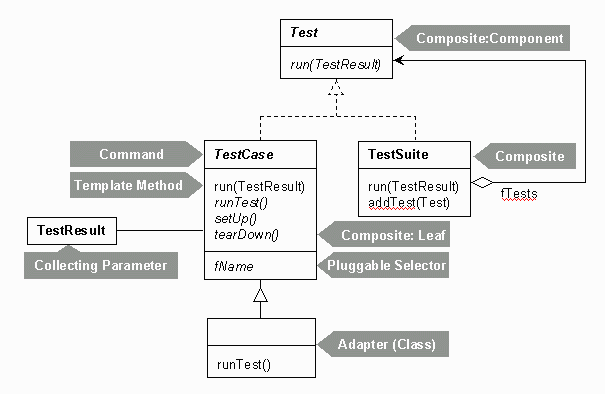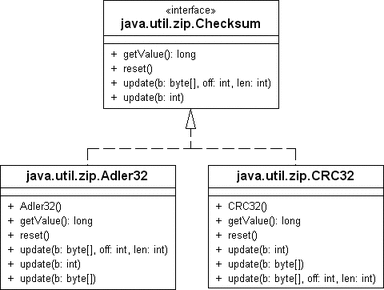JPatterns: Annotations for clearly specifying Design Patterns in Java
JPatterns is a collection of annotations that should make it easier to communicate the use of Design Patterns within your code to your fellow developers and your future self.
Design Patterns are typically encoded into Java code in an ad-hoc fashion. They are either embedded into the names of the classes or written into the Javadocs. Unfortunately it is impossible to accurately determine a pattern based solely on the class structure without knowing the intent of the code author.
We follow the KISS principle by using reasonable defaults for the annotation attributes. Thus, if you are writing a composite, you can simply specify:
@CompositePattern public abstract class Contact {
public abstract void sendMail(String msg);
public void add(Contact contact) {
}
public void remove(Contact contact) {
}
}
Or, if you wanted to, you could also be more explicit, for example
@CompositePattern(role = CompositeRole.COMPONENT, participants = {
DistributionList.class, Person.class
}
) public abstract class Contact {
public abstract void sendMail(String msg);
public void add(Contact contact) {
}
public void remove(Contact contact) {
}
}
Please see the JavaDocs for complete reference of annotations.
Presentation
This is presentation from Devoxx in Antwerp, Belgium.
What is JPatterns.org?
- Java annotations for describing patterns in code
- Formalises pattern usage
- In future, we might write tools to extract annotations to help describe systems
What is JPatterns.org not?
- A set of tools for verifying correct implementation of patterns
- Patterns help us get started, but they are not final solution
- The structure is the weakest dominator in the pattern
- More important is intent and name
- jpatterns annotates your intent
- How would you verify that a class is a Singleton?
Example Adapter Without Annotations
public class Rapper {
public String talk() {
return "Vulgar lyrics deleted...";
}
}
public class RapperClassAdapter extends Rapper implements Singer {
public String sing() {
return talk();
}
}
Example Adapter With Basic Annotation
public class Rapper {
public String talk() {
return "Vulgar lyrics deleted...";
}
}
import org.jpatterns.gof.*; @AdapterPattern public class RapperClassAdapter extends Rapper implements Singer {
public String sing() {
return talk();
}
}
Example Adapter With Detailed Annotation
@AdapterPattern.Adaptee public class Rapper {
public String talk() {
return "Vulgar lyrics deleted...";
}
}
@AdapterPattern.Adapter(
value = AdapterPattern.Variation.CLASS,
participants = {
Rapper.class, Singer.class
}
) public class RapperClassAdapter extends Rapper implements Singer {
public String sing() {
return talk();
}
}
Why do we need this?
- Programmers design using well established patterns
- The pattern might not be that obvious to others
- e.g. JUnit was developed test-driven, but Gamma and Beck were talking in patterns
Classic Methodologies
- e.g. Waterfall Model: Analysis, Design, Implementation, Testing
- Suffers from “Analysis Paralysis”
- Bad decision during analysis very expensive
- Model for large teams with greatly varying skill-sets
- Each iteration takes months
Agile Methodologies
- e.g. eXtreme Programming
- All programming is done in pairs
- For constant code reviewing, NOT mentoring
- Very short iterations (days or weeks)
- Testing is done several times a day
- Daily automated build and complete test
- Designing with Patterns
- Ruthless refactoring
Which Methodology to Use?
- Waterfall Model
- One or two excellent analysts
- Few good designers
- Lots of average programmers
- Suffers from “Peter Principle”
- eXtreme Programming
- Between 6 and 12 above average programmers per team
- Fosters cooperation, not competition in team
- Low staff turnover
- Chaos if not strictly managed!!!
Typical Day as Programmer
Let's look at Joe's day at work:
- 08:00 Arrive at work
- 08:30 Had first cup of coffee, erased SPAM
- 09:00 Chatted with coworker about soccer
- 10:00 Had project status meeting
- 11:00 Thought about design problems
- (Whilst playing minesweeper)
- 12:30 Looked at some critical bugs for important customer
- 13:30 Finished playing “Battlefield 1942” with colleagues
- 15:00 Wrote 200 lines of VB code, answered 5 phone calls
- 16:30 Company meeting entitled “Be more productive”
- 17:30 Wrote emails to bosses and colleagues (and friends)
- 23:30 Time to go home - finished writing TCP/IP stack in assembler
Programming is a Minority Task
- Most of your time is spent in:
- Meetings
- Documentation
- Planning
- Testing, bug fixing & support
- Even brilliant programmers have to communicate!
Design Language can Help
- Meetings
- Communicate more effectively about your designs to colleagues
- Documentation
- Code documentation can refer to Design Pattern
- Planning
- You can talk in higher-level components
- Testing, bug fixing & support
- Better designs will reduce bugs and make code easier to change
Organic First Cold Pressed Virgin Olive Oil
- Design Patterns are like good olive oil
- You cannot appreciate them at first
- As you study them you learn the difference between supermarket oil and the real stuff from Heinz's farm
- As you become a connoisseur you experience the various textures you didn’t notice before
- Warning: Once you are hooked, you will no longer be happy with bottled oil!
Design Patterns Origin
The Timeless Way of Building. Christopher Alexander
There is a central quality which is the root criterion of life and spirit in a man, a town, a building, or a wilderness. If you want to make a living flower, you don’t build it physically, with tweezers, cell by cell. You grow it from the seed.
Why are patterns so important?
- Provide a view into the brains of OO experts
- Help you understand existing designs
- Patterns in Java, Volume 1, Mark Grand writes
- "What makes a bright, experienced programmer much more productive than a bright, but inexperienced, programmer is experience."
What’s in a name?
The Timeless Way of Building
The search for a name is a fundamental part of the process of inventing or discovering a pattern. So long as a pattern has a weak name, it means that it is not a clear concept, and you cannot tell me to make “one”.
Where are patterns usually documented?
- In the class name: TreeVisitor, FilteredOutputStream
- But often not, e.g. Runtime, Runnable, Checksum
- In UML class diagrams as text notes
- But seriously, who draws UML diagrams nowadays?
- There is no proper tooling support
- In the JavaDocs, but inconsistently
- In a separate design document
JUnit Patterns Overview
From the JUnit Cook's Tour
How do the annotations work?
Code with JPatterns.org Annotations
@StrategyPattern.Strategy public interface Checksum {
long getValue();
void reset();
void update(int b);
}
@StrategyPattern.ConcreteStrategy public class Adler32 implements Checksum {
...
}
@StrategyPattern.Context public class FlatFileDatabase {
@StrategyPattern.StrategyField
private final Checksum checksum;
}
About
jpatterns.org was conceived during one of the Java Specialists Club design patterns sessions as a way to clearly label classes as belonging to some pattern structure using Java annotations. The project is led by Michael Hunger and Heinz Kabutz.

